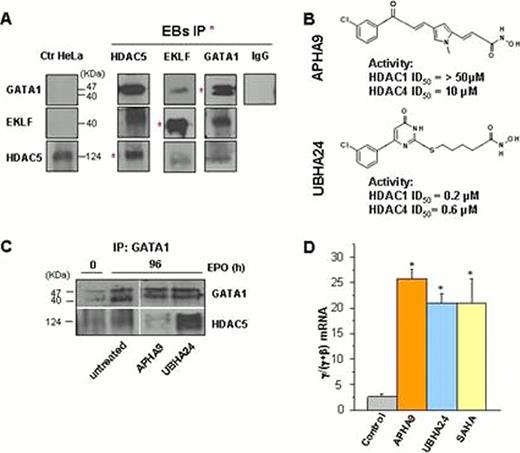Abstract
Abstract 979
Histone deacetylation, the reaction that maintains chromatin in a condensed configuration preventing gene expression, is catalyzed by the histone deacetylase (HDAC) superfamily. The human HDAC family includes 18 different isoforms classified on the basis of their sequence homology to HDACs from Saccharomyces Cerevisiae into class I (HDAC1, −2, −3, and −8), IIa (HDAC4, −5, −7, and −9), IIb (HDAC6 and −10) and IV (HDAC11). Class I HDACs bind the DNA directly while class IIa HDACs shuffles other proteins between nucleus and cytoplasm. While the role of individual class I HDACs in erythropoiesis is starting to emerge, that of class IIa and b HDACs is still largely unknown. To clarify the role played by class IIa HDACs in the control of human erythropoiesis, an extensive analysis of expression, activity, and function of different classes of HDACs during the maturation of erythroblasts derived in vitro from adult blood or cord blood was performed.
Erythroid maturation was associated with increased expression of class I HDACs (both mRNA and protein) which, in the case of HDAC1, was also associated with increased enzymatic activity and association with its NuRD partner GATA1. By contrast, reductions either in expression (HDAC4) or activity (HDAC5) of class IIa HDACs were observed with maturation. In addition, GATA1 and EKLF were consistently found associated in human erythroblasts but EKLF was not found associated with HDAC1. The extent of nuclear-cytoplasmic trafficking of class I (HDAC1 and 2) and IIa (HDAC4 and 5) and of the transcription factors EKLF and GATA1 in response to EPO was determined. HDAC2/EKLF/GATA1 and HDAC4 were found constitutively present in the nucleus and in the cytoplasm, respectively. By contrast, the nuclear concentration of HDAC1 increased while that of HDAC5 and of GATA1fl decreased upon stimulation with EPO. The last two observations suggested that HDAC5, GATA1 and EKLF might be associated in a complex.
A series of IPs followed by WB experiments showed that HDAC5 was consistently associated with EKLF and GATA1 and conversely, both GATA1 (preferentially GATA1fl over GATA1s) and EKLF were consistently associated with HDAC5 (Fig 1A and not shown). Interestingly also pERK was detected in IPs with HDAC5, EKLF and GATA1 antibodies. These results indicate that in erythroid cells HDAC5 forms a complex with GATA1, EKLF and pERK.
The association between GATA1/EKLF was greater in cells generated with cord blood (which express high HbF levels) than in those derived from adult blood and their association decreased with maturation, suggesting that the complex may regulate HbF expression. To confirm this hypothesis, HDAC5/GATA1 association and γ/(γ+ β) mRNA ratios were determined in erythroid cells induced to mature in the presence of a pan-class II-specific (APHA9, ID50=20 μM for HDAC4) HDAC inhibitor (HDACi) (Fig 1B)1. Cells exposed in parallel to the class I/IIa-specific (UBHA24, ID50 =0.2 and 0.6 μM for HDAC1 and HDAC4, respectively) HDACi, were used as control. Exposure to APHA9 reduced the association between GATA1 and HDAC5 and increased γ/(γ + β) mRNA expression ratio, while this association was not affected by exposure to the class I/II HDACi which, as expected, also increased γ/(γ+ β) mRNA ratio.
These data identify a new HDAC complex formed by HDAC5, EKLF and GATA1 that regulates γ/(γ + β) ratio. We hypothesize that the biological role of this new complex is to shuffle GATA1 and EKLF from the cytoplasm to the nucleus, making them able to engage into the NuRD and Sin3A complex respectively, and that inhibition of the activity of this complex affects γ-globin expression indirectly by limiting the amount of GATA1and EKLF available to associate with NuRD and Sin3A.
No relevant conflicts of interest to declare.
References
Author notes
Asterisk with author names denotes non-ASH members.


This feature is available to Subscribers Only
Sign In or Create an Account Close Modal